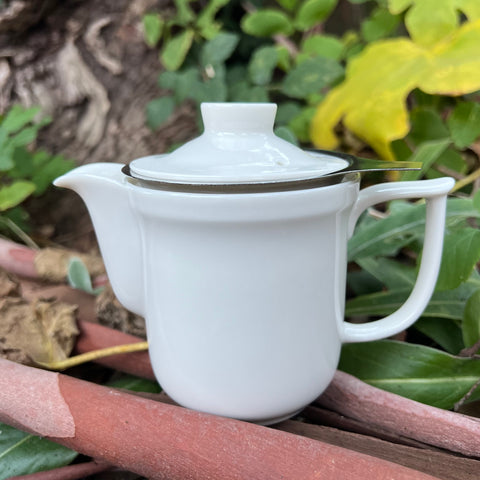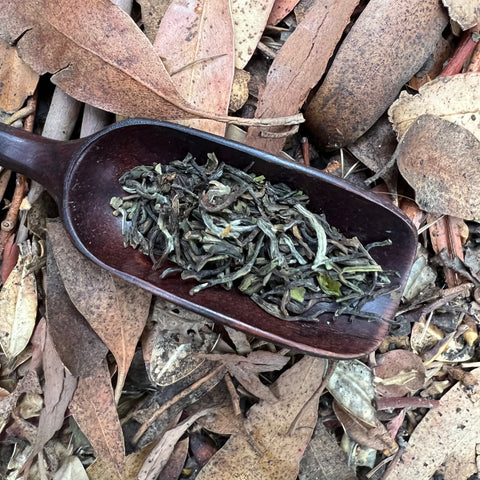2025 Second Flush Darjeeling Tea [Niroulas Tea Cooperative]
Simply put...
Niroulas Second Flush Darjeeling Tea delivers deeper toastier notes than the first flush offering a warming & nourishing cup with the delicate undertones you expect from Darjeeling.
This tea will be delivered in our new compostable packaging >> read more here
In more depth...
Tea Name : Niroulas Second Flush
Tea Maker : Bhawesh Niroula
Origin : Niroulas Cooperative, Chotta Poobong Busty, Near Ghoom, Darjeeling
Size : Personal ancestral plantation area of 25 acres and green tea leaves from 180 small tea growers in and around Darjeeling. The total tea plantation area is 350 acres.
Harvest Time : 1st week June
Cultivar : Mixed Clonal- ( AV2, P312, Takdah 78 and Gomtee ) and China bushes.
Grade : SFTGFOP1
Plucking standard :
Processing : Withered, rolled, oxidised and fired.
Experience : The tea makes a dark amber liquor and delivers a deeper toastier cup - both warming and nourishing.
Last visited by Comins : July 2018, Michelle Comins
How to prepare tea [Western Style]...
Amount of tea per cup (200 ml): 5g (one tea caddy spoon)
Temperature of water: 95℃ / 185℉ (boil kettle, cool for 20 seconds)
Infusion time: 2-4 minutes (or as desired)
Number of infusions: 1-2
How to enjoy: No milk, no sugar
Tales of the Tea Trade : Niroula's
Michelle : Extract from our our book Tales of the tea trade :
Bhawesh :The story starts with my father, Bikram, a retired government employee who started planting tea in 1999 as an alternative crop because all the other conventional farming was not successful due to the local wildlife destroying it [...] ‘My father has always talked about helping the poor small tea growers in Darjeeling, so we started thinking about how to make tea farming in our village a viable way of life again. After a year of research and the con dence of a bank in me, we started Darjeeling’s first farming cooperative in 2015 and built our own manufacturing unit to support it. We now collect leaves from neighbouring farmers at a very good price (two to three times the average rate), a model that is encouraging new local plantations. People who may previously have given up on farming and left for more lucrative possibilities in the city are starting to see the opportunities that can come from cultivating tea [...]



![2025 Second Flush Darjeeling Tea [Niroulas Tea Cooperative]](http://cominstea.com/cdn/shop/products/image_a0d03358-4deb-407a-9d97-a8aa01e93aec_1024x1024.jpg?v=1610808306)
![2025 Second Flush Darjeeling Tea [Niroulas Tea Cooperative]](http://cominstea.com/cdn/shop/products/image_a0d03358-4deb-407a-9d97-a8aa01e93aec_grande.jpg?v=1610808306)
![2025 Second Flush Darjeeling Tea [Niroulas Tea Cooperative]](http://cominstea.com/cdn/shop/products/image_9bc46853-a3b7-4c55-9db0-9d9d7e4f2189_grande.jpg?v=1610808669)
![2025 Second Flush Darjeeling Tea [Niroulas Tea Cooperative]](http://cominstea.com/cdn/shop/products/image_942f0d22-7d4f-4193-aea2-2186ea2aa239_grande.jpg?v=1610808669)
![2025 Second Flush Darjeeling Tea [Niroulas Tea Cooperative]](http://cominstea.com/cdn/shop/products/Bharwesh_3_814b8322-4734-47f5-83df-3192720f90fd_grande.jpg?v=1610808669)
![2025 Second Flush Darjeeling Tea [Niroulas Tea Cooperative]](http://cominstea.com/cdn/shop/products/image_2fa23b3f-75fc-4582-a0ed-be0bdf3c2f09_grande.jpg?v=1610808669)
![2025 Second Flush Darjeeling Tea [Niroulas Tea Cooperative]](http://cominstea.com/cdn/shop/products/image_ebff1c50-6a05-4382-9258-2c63ed589df0_grande.jpg?v=1610808669)
![2025 Second Flush Darjeeling Tea [Niroulas Tea Cooperative]](http://cominstea.com/cdn/shop/products/Bharwesh_4_605efc13-a185-40a2-886f-7920f2739ea4_grande.jpg?v=1610808669)
![2025 Second Flush Darjeeling Tea [Niroulas Tea Cooperative]](http://cominstea.com/cdn/shop/products/Niroulas_1_f533ce1a-091a-4bdf-99c0-2e9aa0f578f6_grande.jpg?v=1610808669)
![2025 Second Flush Darjeeling Tea [Niroulas Tea Cooperative]](http://cominstea.com/cdn/shop/products/Niroulas_2_4e15c8da-0901-4baa-b2be-6cb95376d16a_grande.jpg?v=1610808669)
![2025 Second Flush Darjeeling Tea [Niroulas Tea Cooperative]](http://cominstea.com/cdn/shop/products/Niroulas_3_c4e6b6cc-c818-40d7-9600-5ae21b352abd_grande.jpg?v=1610808669)
![2025 Second Flush Darjeeling Tea [Niroulas Tea Cooperative]](http://cominstea.com/cdn/shop/products/Bharwesh_7_7ec3ed75-6f9a-4042-b49d-31c3096cae71_grande.jpg?v=1610808669)
![2025 Second Flush Darjeeling Tea [Niroulas Tea Cooperative]](http://cominstea.com/cdn/shop/products/Bharwesh_6_9c7d2684-dc20-4b76-a554-370ec27fafb8_grande.jpg?v=1610808669)
![2025 Second Flush Darjeeling Tea [Niroulas Tea Cooperative]](http://cominstea.com/cdn/shop/products/Bharwesh_5_99a9dac5-5e26-4273-95c1-9f82360332bc_grande.jpg?v=1610808669)
![2025 Second Flush Darjeeling Tea [Niroulas Tea Cooperative]](http://cominstea.com/cdn/shop/products/Bharwesh_2_b8b4c9cf-f10c-4240-b398-9999008117e2_grande.jpg?v=1610808669)
![2025 Second Flush Darjeeling Tea [Niroulas Tea Cooperative]](http://cominstea.com/cdn/shop/products/Bharwesh_1_ab277ab0-31ee-431a-8125-4027e2235556_grande.jpg?v=1610808669)
![2025 Second Flush Darjeeling Tea [Niroulas Tea Cooperative]](http://cominstea.com/cdn/shop/products/image_50329e34-48cd-442c-ada5-c53f30304022_grande.jpg?v=1610808669)
![2025 EXPLORE Black Tea [3 tea gift box]](http://cominstea.com/cdn/shop/files/335994DE-05DF-483B-844A-5602BA9DC729_large.heic?v=1700753987)

![Jun’s Jungjak Black Tea [South Korea]](http://cominstea.com/cdn/shop/files/1C967791-BAD6-41C1-98DF-71372D959E1D_large.jpg?v=1731863934)
